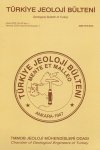
-
2025
-
2024
-
2023
-
2022
-
2021
-
2020
-
2019
-
2018
-
2017
-
2016
-
2015
-
2014
-
2013
-
2012
-
2011
-
2010
-
2009
-
2008
-
2007
- 2006
-
2005
-
2004
-
2003
-
2002
-
2001
-
2000
-
1999
-
1998
-
1997
-
1996
-
1995
-
1994
-
1993
-
1992
-
1991
-
1990
-
1989
-
1988
-
1987
-
1986
-
1985
-
1984
-
1983
-
1982
-
1981
-
1980
-
1979
-
1978
-
1977
-
1976
-
1975
-
1974
-
1973
-
1972
-
1971
-
1970
-
1969
-
1968
-
1966
-
1964
-
1963
-
1961
-
1959
-
1958
-
1955
-
1954
-
1953
-
1952
-
1951
-
1950
-
1949
-
1948
-
1947
Abstract: The Koyunbabafault is located on the western margin ofÇankırı basin (Central Anatolia) where the neotectonic evolution is debated. The fault is located between Early-Middle Miocene Hançili formation of Çankırı basin and the ophiolitic rocks of Neo- Tethyan suture zone. The type ofthe Koyunbabafault, however, is interpreted differently in some studies.The Koyunbaba fault has variably sized slickensides with well-developed slickenlines. The fault comprises NW-SE trending fault planes dipping between 25-40° to the SW. Slickenlines trend NE-SW with plunging SW. The surface displays undulations with centimeters to meters wave length. Slickenlines and undulation axes are parallel to each other. Cataclastic zone that occurred, in the footwall block ofthe Koyunbaba fault is characterized by breccias and cataclasites. The zone includes mesoscopic and microscopic brittle kinematic indicators (tensiongashes, inclined planar structures, asymmetric deformed elements, Riedelfractures) indicating that hanging wallmoved to southwest and Koyunbabafault is a normal fault. Thisfinding supports the existence ofa tectonic sliver having normal and thrust faults on the western and eastern margins respectively.
Abstract: The Upper Cretaceous Yavcaformation crops out as a narrow belt in vicinity ofthe Arslanköy town (NWMersin). This region represents the northernpassive margin of the Menderes-Taurides Block, and have been come in nappe movement overtheMenderes-Taurides Blockduring the Late Cretaceous.The Yavcaformation deposited in the slope and basin plain environment overlies the Campanian slumped micritic limestone belonging the upper level of the Cehennemdere Formation. Over the basal conglomerate including pebbles from Cehennemdere Formation, claret-red-colored planktic foraminifera bearing micritic limestone deposited in this slope environment evolved as a result ofthe movement ofthe basin marginfault. This Carbonate facies is conformably overlain by the Clastic facies that is delineated in Coarse Clastic and Fine Clastic subfacies. Initially, Fine Clastic subfacies comprising grey-green colored, laminated claystone andfinegrained sandstone alternations are observed. Then due to repeated activity ofthe basin margin faults, CoarseClastic subfacies that contains an alternations of conglomerate-sandstone are deposited. The sedimentarypackages in this subfacies start with clast supported conglomerates, and pass in matrix supported conglomerates - sandstone towards the basin interior in the direction ofsediment transportation. The Yavcaformation ends`with claystone andfine-grained sandstone alternations deposited in the deep sea environment including the slumped micritic limestone blocks.Coarse-grained sediments, slumps and deformed beddings indicate the submarine slope environment evolution in the western part ofthe study area. Disappearance ofthese properties through the east in the short distance shows that slope environment passed in the deep sea environment.
Abstract: Theplatform carbonates cropping out to the southest of Sivas are named under different litostratigraphic names and assigned to different ages. In this study, according to foraminifers (Auloconus permodiscoides,Aulotortus communis, A.friedli, A. sinuosııssinuosııs, Triasina hantkeni, Trochammina sp. aff. T alpina, T sp. aff.Tjaunensis), a Norian-Rhaetian age was discovered in this carbonate succession. The correlation of Munzur and Sivas sections suggests that these carbonates should be namedas the Munzur Limestone.
Abstract: The aim ofthisstudy is to examine the mineralogical and chemical changes, caused by epithermalsolutionswhich were mineralizingfluids ofTertiary mercury deposit, in trachyandesite wall-rocks. The oldest unit in thestudy area is marble of the Silurian - Lower Carboniferus Bozdağ formation. The Carboniferous - PermianBağrıkurtformation lies comformablyon the Bozdağformation and consists ofgenerallyphyllite, metasandstone,metachert, quartzite, calcschist with limestone lens. The Triassic aged metatrachyandesite cut across these unitsand cover them. In the metatrachyandesite common alteration products such as uralitation, chlorization,sericitation, silicification, saossuritization are observed. The metatrachyandesite shows thatstandart deviationsofAu, Ba, Cu, Hg, Pb, and Sb values are high, and refects that epithermal stage metals enrichment related to typical primary alteration. The amounts of REEs, especially LREEs of metatrachyandesite are cpiite high.Chondrite- andMORB-nortnalizedpatterns ofREEsshowgradual and regular decreasesfrom LREEs to HREEs.The results ofclusterandfactoranalysesofthe data indicate a hydrothermal alteration tracer.

 TMMOB
TMMOB